Spread Spectrum Transmission & Radio System Components Analysis
VerifiedAdded on 2023/06/13
|7
|976
|434
Report
AI Summary
This report provides an overview of wireless networking concepts, focusing on spread spectrum transmission and radio systems. It details the usage of spread spectrum in jam-resistant systems, global positioning, and wireless LANs, comparing Direct Sequence Spread Spectrum (DSSS) and Frequency Hopping Spread Spectrum (FHSS) methods. The report also outlines the components of a radio system, including transmitters and receivers, and explains the functionality of mixers in frequency mixing. Different types of mixers, such as single device, single balanced, and double-balanced mixers, are also discussed. Finally, the assignment brief requires a presentation on advanced wireless technologies and future antenna types.
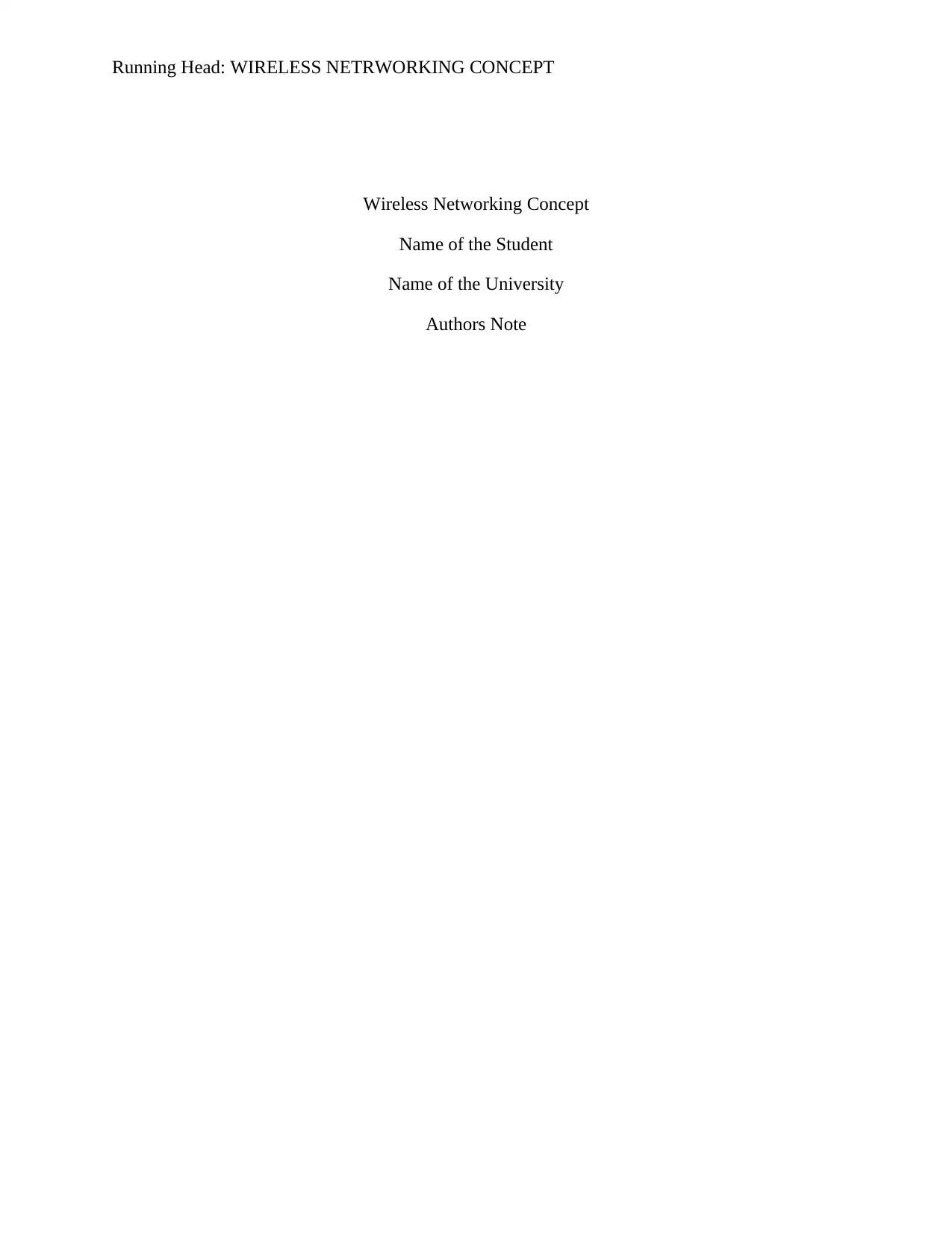
Running Head: WIRELESS NETRWORKING CONCEPT
Wireless Networking Concept
Name of the Student
Name of the University
Authors Note
Wireless Networking Concept
Name of the Student
Name of the University
Authors Note
Paraphrase This Document
Need a fresh take? Get an instant paraphrase of this document with our AI Paraphraser
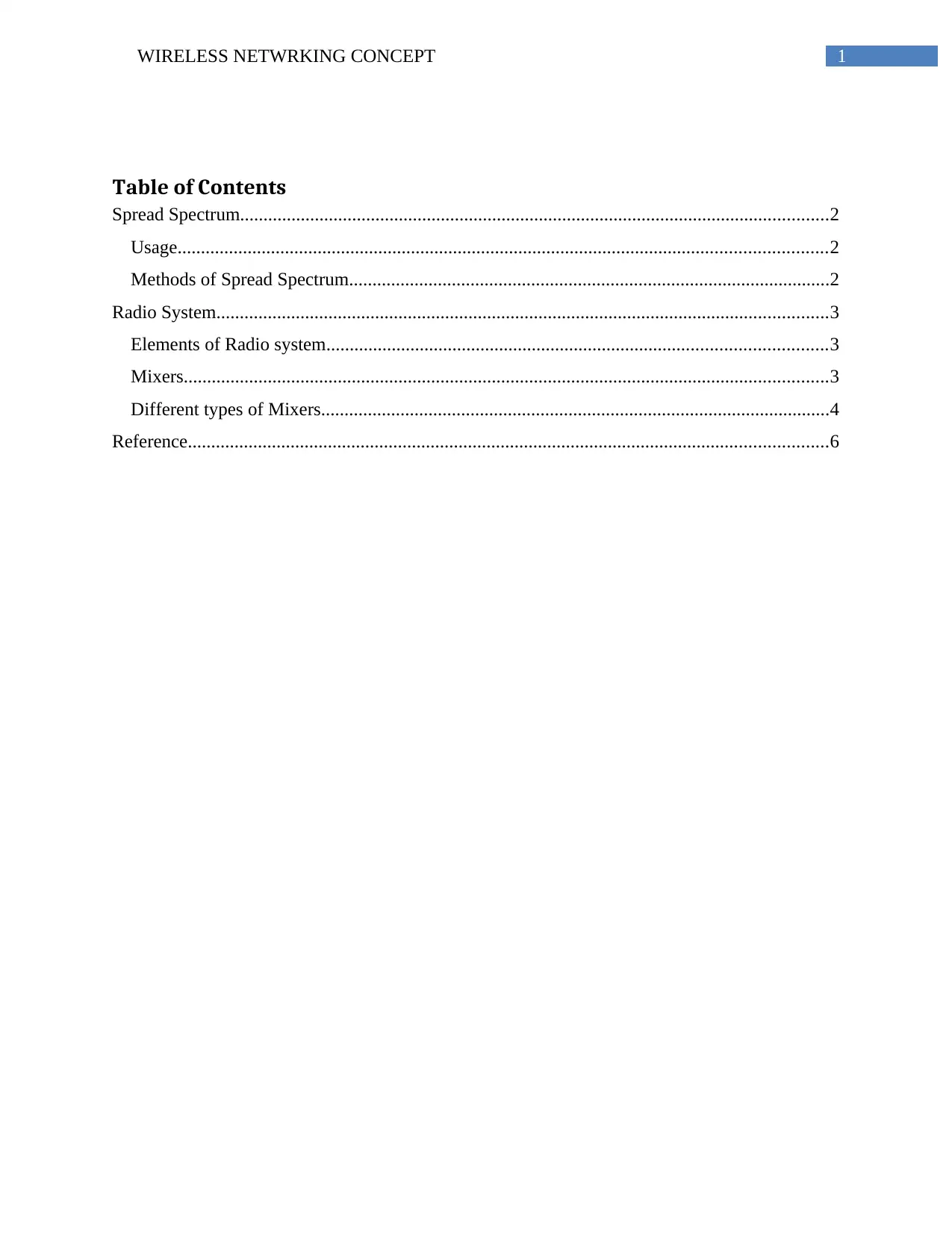
1WIRELESS NETWRKING CONCEPT
Table of Contents
Spread Spectrum..............................................................................................................................2
Usage...........................................................................................................................................2
Methods of Spread Spectrum.......................................................................................................2
Radio System...................................................................................................................................3
Elements of Radio system...........................................................................................................3
Mixers..........................................................................................................................................3
Different types of Mixers.............................................................................................................4
Reference.........................................................................................................................................6
Table of Contents
Spread Spectrum..............................................................................................................................2
Usage...........................................................................................................................................2
Methods of Spread Spectrum.......................................................................................................2
Radio System...................................................................................................................................3
Elements of Radio system...........................................................................................................3
Mixers..........................................................................................................................................3
Different types of Mixers.............................................................................................................4
Reference.........................................................................................................................................6
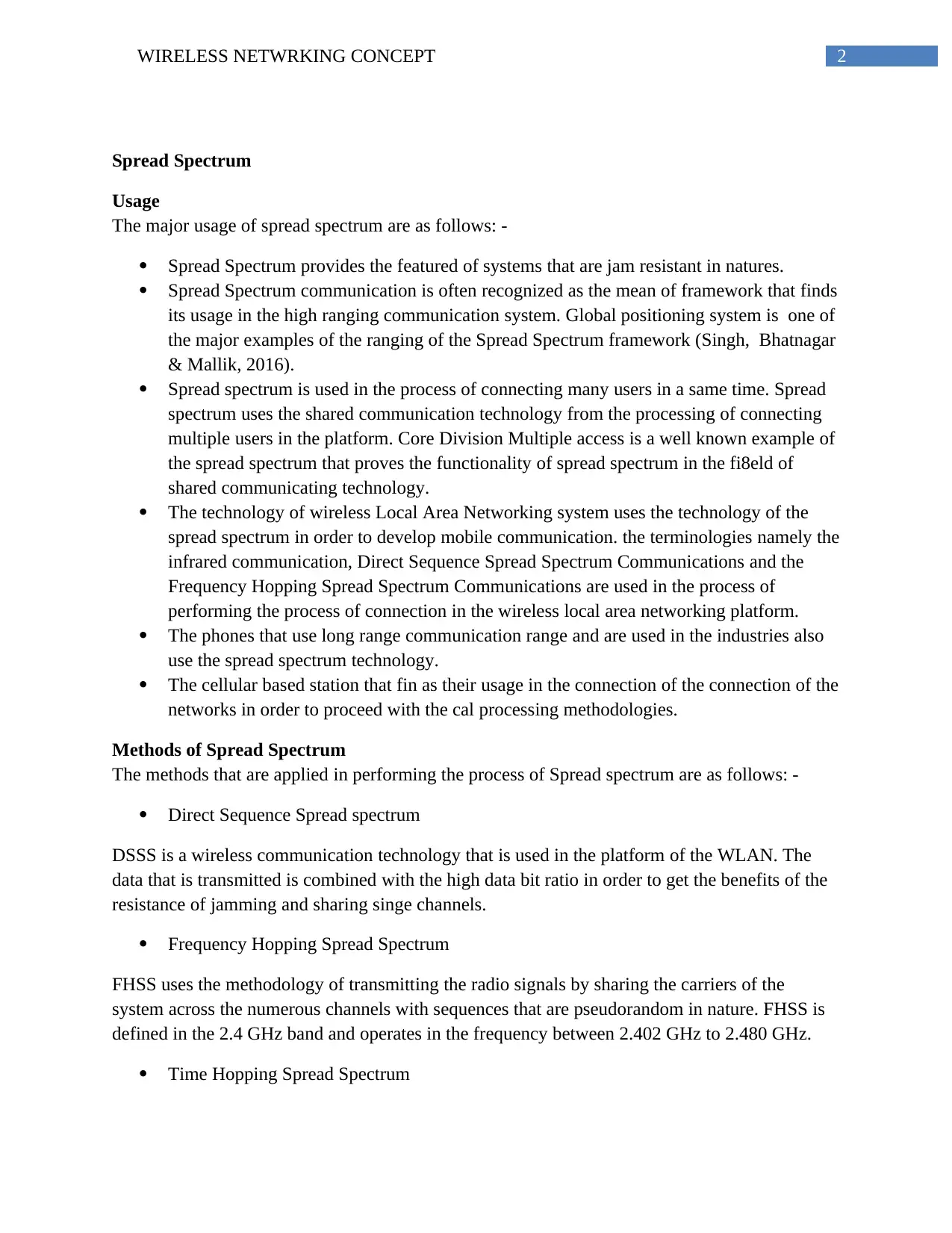
2WIRELESS NETWRKING CONCEPT
Spread Spectrum
Usage
The major usage of spread spectrum are as follows: -
Spread Spectrum provides the featured of systems that are jam resistant in natures.
Spread Spectrum communication is often recognized as the mean of framework that finds
its usage in the high ranging communication system. Global positioning system is one of
the major examples of the ranging of the Spread Spectrum framework (Singh, Bhatnagar
& Mallik, 2016).
Spread spectrum is used in the process of connecting many users in a same time. Spread
spectrum uses the shared communication technology from the processing of connecting
multiple users in the platform. Core Division Multiple access is a well known example of
the spread spectrum that proves the functionality of spread spectrum in the fi8eld of
shared communicating technology.
The technology of wireless Local Area Networking system uses the technology of the
spread spectrum in order to develop mobile communication. the terminologies namely the
infrared communication, Direct Sequence Spread Spectrum Communications and the
Frequency Hopping Spread Spectrum Communications are used in the process of
performing the process of connection in the wireless local area networking platform.
The phones that use long range communication range and are used in the industries also
use the spread spectrum technology.
The cellular based station that fin as their usage in the connection of the connection of the
networks in order to proceed with the cal processing methodologies.
Methods of Spread Spectrum
The methods that are applied in performing the process of Spread spectrum are as follows: -
Direct Sequence Spread spectrum
DSSS is a wireless communication technology that is used in the platform of the WLAN. The
data that is transmitted is combined with the high data bit ratio in order to get the benefits of the
resistance of jamming and sharing singe channels.
Frequency Hopping Spread Spectrum
FHSS uses the methodology of transmitting the radio signals by sharing the carriers of the
system across the numerous channels with sequences that are pseudorandom in nature. FHSS is
defined in the 2.4 GHz band and operates in the frequency between 2.402 GHz to 2.480 GHz.
Time Hopping Spread Spectrum
Spread Spectrum
Usage
The major usage of spread spectrum are as follows: -
Spread Spectrum provides the featured of systems that are jam resistant in natures.
Spread Spectrum communication is often recognized as the mean of framework that finds
its usage in the high ranging communication system. Global positioning system is one of
the major examples of the ranging of the Spread Spectrum framework (Singh, Bhatnagar
& Mallik, 2016).
Spread spectrum is used in the process of connecting many users in a same time. Spread
spectrum uses the shared communication technology from the processing of connecting
multiple users in the platform. Core Division Multiple access is a well known example of
the spread spectrum that proves the functionality of spread spectrum in the fi8eld of
shared communicating technology.
The technology of wireless Local Area Networking system uses the technology of the
spread spectrum in order to develop mobile communication. the terminologies namely the
infrared communication, Direct Sequence Spread Spectrum Communications and the
Frequency Hopping Spread Spectrum Communications are used in the process of
performing the process of connection in the wireless local area networking platform.
The phones that use long range communication range and are used in the industries also
use the spread spectrum technology.
The cellular based station that fin as their usage in the connection of the connection of the
networks in order to proceed with the cal processing methodologies.
Methods of Spread Spectrum
The methods that are applied in performing the process of Spread spectrum are as follows: -
Direct Sequence Spread spectrum
DSSS is a wireless communication technology that is used in the platform of the WLAN. The
data that is transmitted is combined with the high data bit ratio in order to get the benefits of the
resistance of jamming and sharing singe channels.
Frequency Hopping Spread Spectrum
FHSS uses the methodology of transmitting the radio signals by sharing the carriers of the
system across the numerous channels with sequences that are pseudorandom in nature. FHSS is
defined in the 2.4 GHz band and operates in the frequency between 2.402 GHz to 2.480 GHz.
Time Hopping Spread Spectrum
⊘ This is a preview!⊘
Do you want full access?
Subscribe today to unlock all pages.

Trusted by 1+ million students worldwide
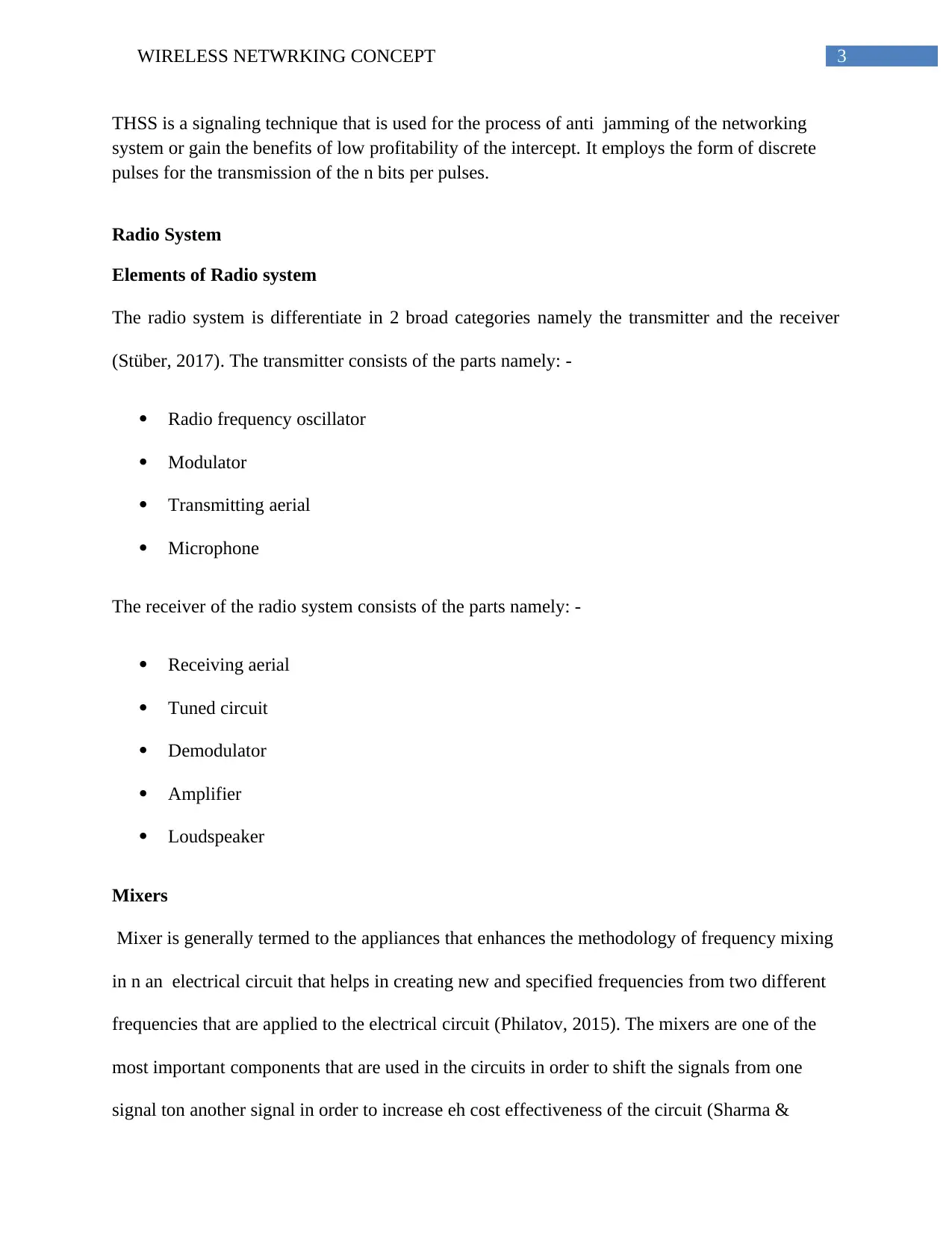
3WIRELESS NETWRKING CONCEPT
THSS is a signaling technique that is used for the process of anti jamming of the networking
system or gain the benefits of low profitability of the intercept. It employs the form of discrete
pulses for the transmission of the n bits per pulses.
Radio System
Elements of Radio system
The radio system is differentiate in 2 broad categories namely the transmitter and the receiver
(Stüber, 2017). The transmitter consists of the parts namely: -
Radio frequency oscillator
Modulator
Transmitting aerial
Microphone
The receiver of the radio system consists of the parts namely: -
Receiving aerial
Tuned circuit
Demodulator
Amplifier
Loudspeaker
Mixers
Mixer is generally termed to the appliances that enhances the methodology of frequency mixing
in n an electrical circuit that helps in creating new and specified frequencies from two different
frequencies that are applied to the electrical circuit (Philatov, 2015). The mixers are one of the
most important components that are used in the circuits in order to shift the signals from one
signal ton another signal in order to increase eh cost effectiveness of the circuit (Sharma &
THSS is a signaling technique that is used for the process of anti jamming of the networking
system or gain the benefits of low profitability of the intercept. It employs the form of discrete
pulses for the transmission of the n bits per pulses.
Radio System
Elements of Radio system
The radio system is differentiate in 2 broad categories namely the transmitter and the receiver
(Stüber, 2017). The transmitter consists of the parts namely: -
Radio frequency oscillator
Modulator
Transmitting aerial
Microphone
The receiver of the radio system consists of the parts namely: -
Receiving aerial
Tuned circuit
Demodulator
Amplifier
Loudspeaker
Mixers
Mixer is generally termed to the appliances that enhances the methodology of frequency mixing
in n an electrical circuit that helps in creating new and specified frequencies from two different
frequencies that are applied to the electrical circuit (Philatov, 2015). The mixers are one of the
most important components that are used in the circuits in order to shift the signals from one
signal ton another signal in order to increase eh cost effectiveness of the circuit (Sharma &
Paraphrase This Document
Need a fresh take? Get an instant paraphrase of this document with our AI Paraphraser
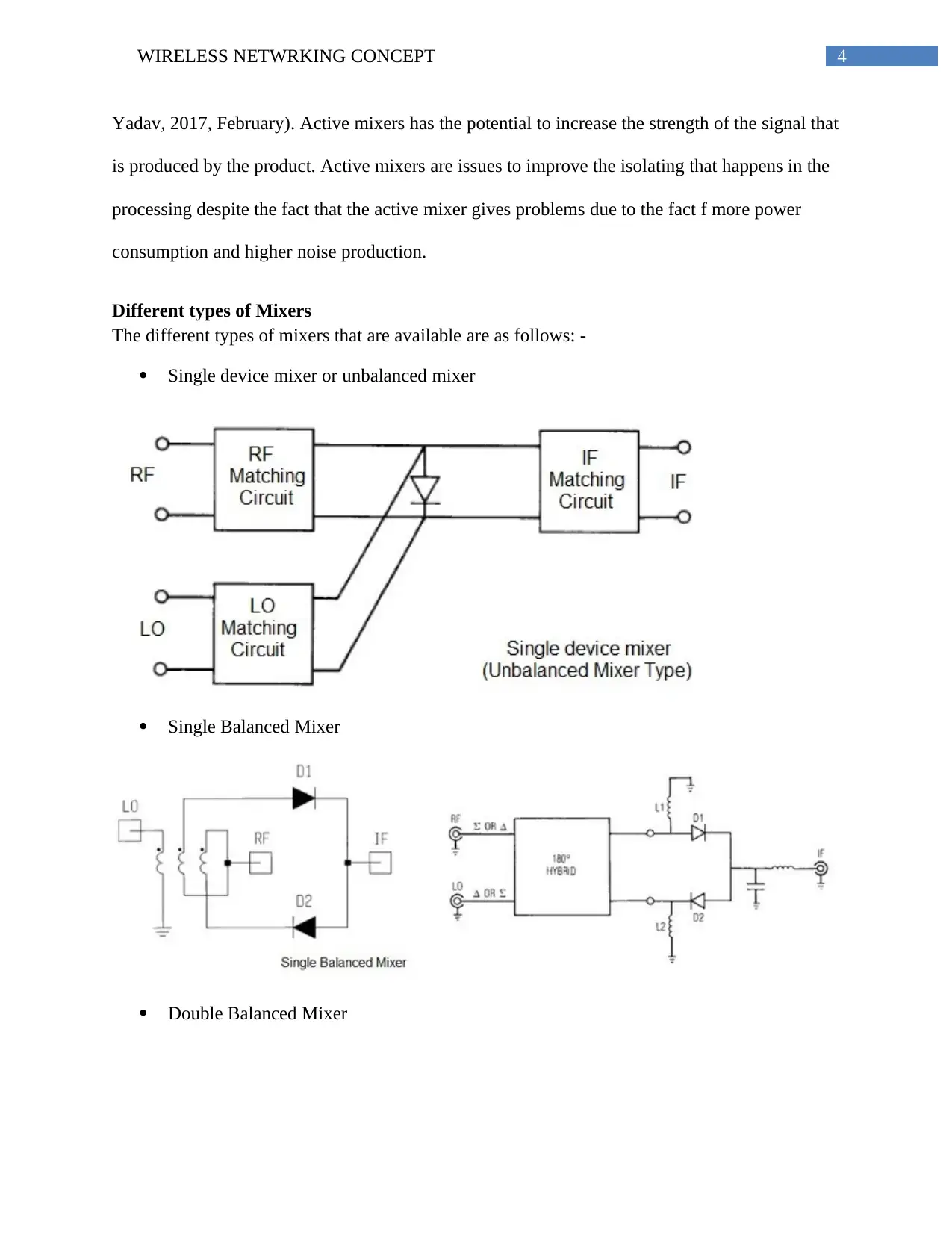
4WIRELESS NETWRKING CONCEPT
Yadav, 2017, February). Active mixers has the potential to increase the strength of the signal that
is produced by the product. Active mixers are issues to improve the isolating that happens in the
processing despite the fact that the active mixer gives problems due to the fact f more power
consumption and higher noise production.
Different types of Mixers
The different types of mixers that are available are as follows: -
Single device mixer or unbalanced mixer
Single Balanced Mixer
Double Balanced Mixer
Yadav, 2017, February). Active mixers has the potential to increase the strength of the signal that
is produced by the product. Active mixers are issues to improve the isolating that happens in the
processing despite the fact that the active mixer gives problems due to the fact f more power
consumption and higher noise production.
Different types of Mixers
The different types of mixers that are available are as follows: -
Single device mixer or unbalanced mixer
Single Balanced Mixer
Double Balanced Mixer
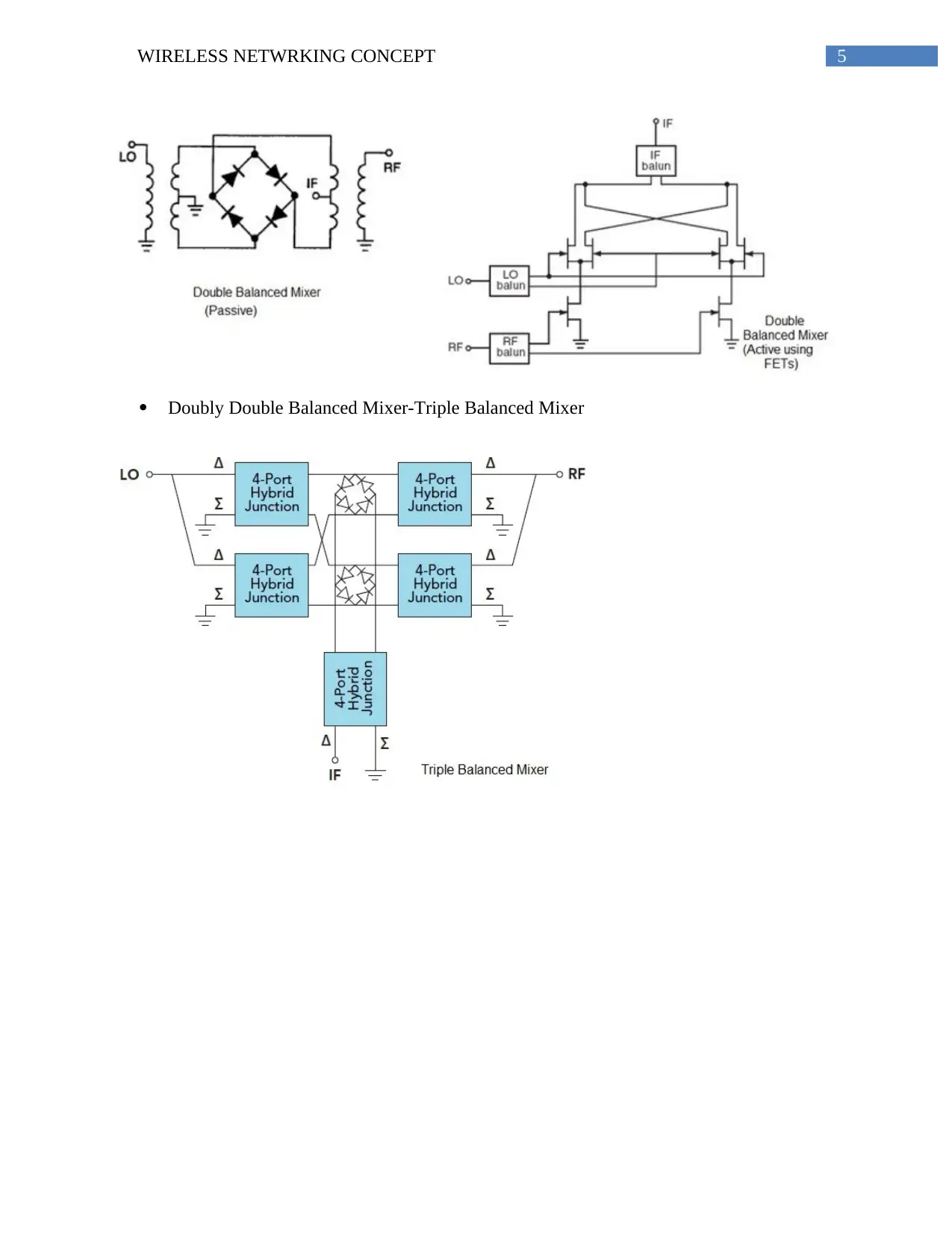
5WIRELESS NETWRKING CONCEPT
Doubly Double Balanced Mixer-Triple Balanced Mixer
Doubly Double Balanced Mixer-Triple Balanced Mixer
⊘ This is a preview!⊘
Do you want full access?
Subscribe today to unlock all pages.

Trusted by 1+ million students worldwide
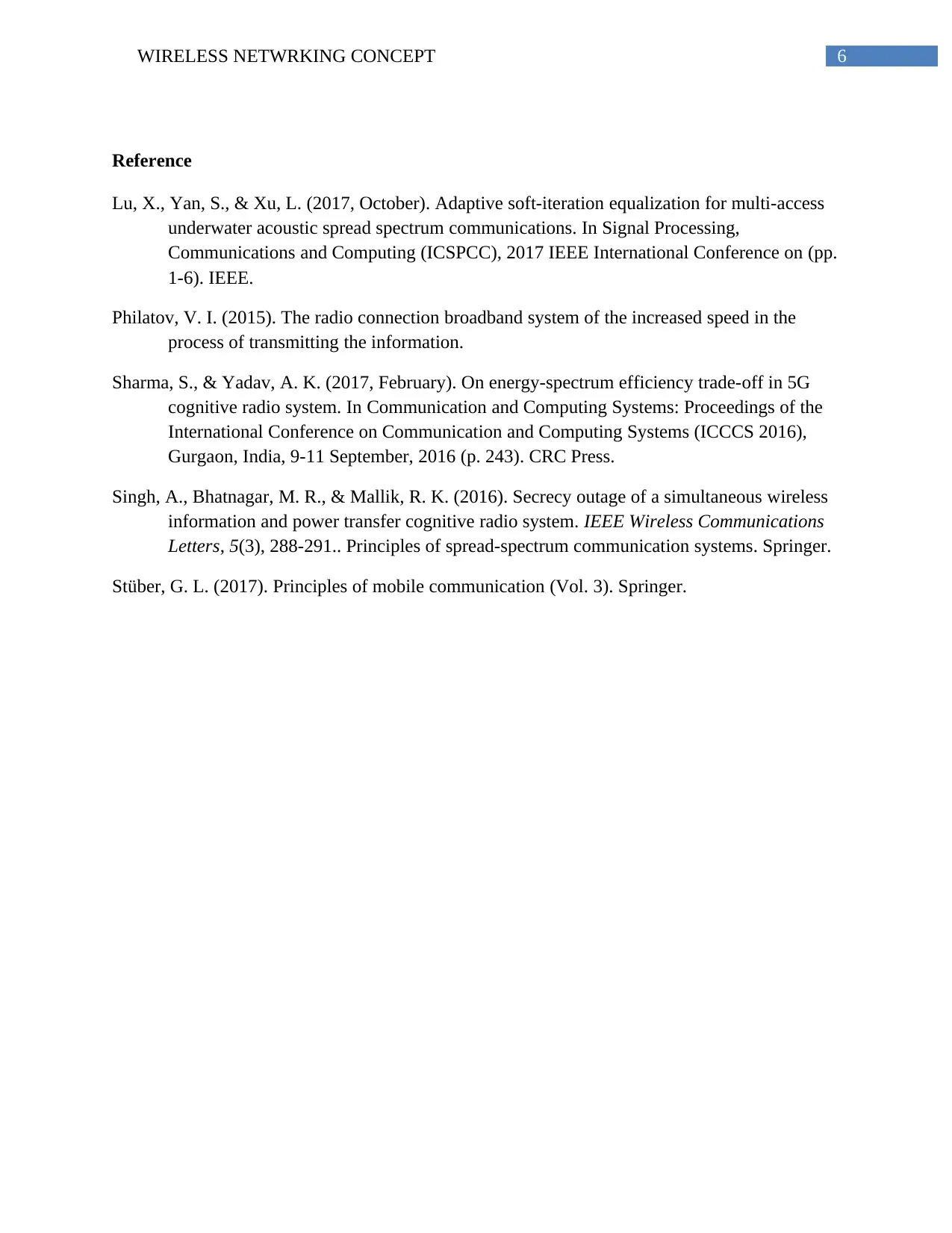
6WIRELESS NETWRKING CONCEPT
Reference
Lu, X., Yan, S., & Xu, L. (2017, October). Adaptive soft-iteration equalization for multi-access
underwater acoustic spread spectrum communications. In Signal Processing,
Communications and Computing (ICSPCC), 2017 IEEE International Conference on (pp.
1-6). IEEE.
Philatov, V. I. (2015). The radio connection broadband system of the increased speed in the
process of transmitting the information.
Sharma, S., & Yadav, A. K. (2017, February). On energy-spectrum efficiency trade-off in 5G
cognitive radio system. In Communication and Computing Systems: Proceedings of the
International Conference on Communication and Computing Systems (ICCCS 2016),
Gurgaon, India, 9-11 September, 2016 (p. 243). CRC Press.
Singh, A., Bhatnagar, M. R., & Mallik, R. K. (2016). Secrecy outage of a simultaneous wireless
information and power transfer cognitive radio system. IEEE Wireless Communications
Letters, 5(3), 288-291.. Principles of spread-spectrum communication systems. Springer.
Stüber, G. L. (2017). Principles of mobile communication (Vol. 3). Springer.
Reference
Lu, X., Yan, S., & Xu, L. (2017, October). Adaptive soft-iteration equalization for multi-access
underwater acoustic spread spectrum communications. In Signal Processing,
Communications and Computing (ICSPCC), 2017 IEEE International Conference on (pp.
1-6). IEEE.
Philatov, V. I. (2015). The radio connection broadband system of the increased speed in the
process of transmitting the information.
Sharma, S., & Yadav, A. K. (2017, February). On energy-spectrum efficiency trade-off in 5G
cognitive radio system. In Communication and Computing Systems: Proceedings of the
International Conference on Communication and Computing Systems (ICCCS 2016),
Gurgaon, India, 9-11 September, 2016 (p. 243). CRC Press.
Singh, A., Bhatnagar, M. R., & Mallik, R. K. (2016). Secrecy outage of a simultaneous wireless
information and power transfer cognitive radio system. IEEE Wireless Communications
Letters, 5(3), 288-291.. Principles of spread-spectrum communication systems. Springer.
Stüber, G. L. (2017). Principles of mobile communication (Vol. 3). Springer.
1 out of 7
Related Documents
Your All-in-One AI-Powered Toolkit for Academic Success.
+13062052269
info@desklib.com
Available 24*7 on WhatsApp / Email
![[object Object]](/_next/static/media/star-bottom.7253800d.svg)
Unlock your academic potential
Copyright © 2020–2025 A2Z Services. All Rights Reserved. Developed and managed by ZUCOL.



